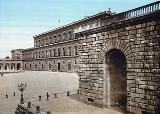
Palazzo Pitti
Encyclopedia
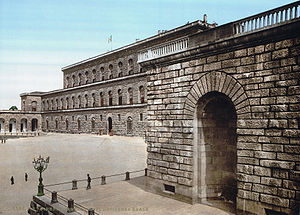

Renaissance
The Renaissance was a cultural movement that spanned roughly the 14th to the 17th century, beginning in Italy in the Late Middle Ages and later spreading to the rest of Europe. The term is also used more loosely to refer to the historical era, but since the changes of the Renaissance were not...
palace
Palace
A palace is a grand residence, especially a royal residence or the home of a head of state or some other high-ranking dignitary, such as a bishop or archbishop. The word itself is derived from the Latin name Palātium, for Palatine Hill, one of the seven hills in Rome. In many parts of Europe, the...
in Florence
Florence
Florence is the capital city of the Italian region of Tuscany and of the province of Florence. It is the most populous city in Tuscany, with approximately 370,000 inhabitants, expanding to over 1.5 million in the metropolitan area....
, Italy. It is situated on the south side of the River Arno, a short distance from the Ponte Vecchio
Ponte Vecchio
The Ponte Vecchio is a Medieval stone closed-spandrel segmental arch bridge over the Arno River, in Florence, Italy, noted for still having shops built along it, as was once common. Butchers initially occupied the shops; the present tenants are jewellers, art dealers and souvenir sellers...
. The core of the present palazzo
Palazzo
Palazzo, an Italian word meaning a large building , may refer to:-Buildings:*Palazzo, an Italian type of building**Palazzo style architecture, imitative of Italian palazzi...
dates from 1458 and was originally the town residence of Luca Pitti
Luca Pitti
Luca Pitti was a Florentine banker during the period of the republic presided over by Cosimo de' Medici. He was a loyal friend and servant to the Medici and the republic...
, an ambitious Florentine banker.
The palace was bought by the Medici
Medici
The House of Medici or Famiglia de' Medici was a political dynasty, banking family and later royal house that first began to gather prominence under Cosimo de' Medici in the Republic of Florence during the late 14th century. The family originated in the Mugello region of the Tuscan countryside,...
family in 1549 and became the chief residence of the ruling families of the Grand Duchy
Grand Duke
The title grand duke is used in Western Europe and particularly in Germanic countries for provincial sovereigns. Grand duke is of a protocolary rank below a king but higher than a sovereign duke. Grand duke is also the usual and established translation of grand prince in languages which do not...
of Tuscany
Tuscany
Tuscany is a region in Italy. It has an area of about 23,000 square kilometres and a population of about 3.75 million inhabitants. The regional capital is Florence ....
. It grew as a great treasure house as later generations amassed paintings, plates, jewelry and luxurious possessions.
In the late 18th century, the palazzo was used as a power base by Napoleon
Napoleon I of France
Napoleon Bonaparte was a French military and political leader during the latter stages of the French Revolution.As Napoleon I, he was Emperor of the French from 1804 to 1815...
, and later served for a brief period as the principal royal palace of the newly united Italy. The palace and its contents were donated to the Italian people by King Victor Emmanuel III in 1919, and its doors were opened to the public as one of Florence's largest art galleries
Art gallery
An art gallery or art museum is a building or space for the exhibition of art, usually visual art.Museums can be public or private, but what distinguishes a museum is the ownership of a collection...
. Today, it houses several minor collections in addition to those of the Medici family, and is fully open to the public.
Early history
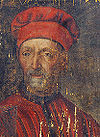
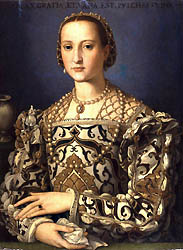
Cosimo de' Medici
Còsimo di Giovanni degli Mèdici was the first of the Medici political dynasty, de facto rulers of Florence during much of the Italian Renaissance; also known as "Cosimo 'the Elder'" and "Cosimo Pater Patriae" .-Biography:Born in Florence, Cosimo inherited both his wealth and his expertise in...
. The early history of the Palazzo Pitti is a mixture of fact and myth. Pitti is alleged to have instructed that the windows be larger than the entrance of the Palazzo Medici
Palazzo Medici Riccardi
The Palazzo Medici, also called the Palazzo Medici Riccardi after the later family that acquired and expanded it, is a Renaissance palace located in Florence, Italy.-History:...
. The 16th-century art historian Giorgio Vasari
Giorgio Vasari
Giorgio Vasari was an Italian painter, writer, historian, and architect, who is famous today for his biographies of Italian artists, considered the ideological foundation of art-historical writing.-Biography:...
proposed that Brunelleschi
Filippo Brunelleschi
Filippo Brunelleschi was one of the foremost architects and engineers of the Italian Renaissance. He is perhaps most famous for inventing linear perspective and designing the dome of the Florence Cathedral, but his accomplishments also included bronze artwork, architecture , mathematics,...
was the palazzo's architect
Architect
An architect is a person trained in the planning, design and oversight of the construction of buildings. To practice architecture means to offer or render services in connection with the design and construction of a building, or group of buildings and the space within the site surrounding the...
, and that his pupil Luca Fancelli
Luca Fancelli
Luca Fancelli was an Italian architect and sculptor.-Biography:Fancelli was born in Settignano, a fraction of Florence...
was merely his assistant in the task but today it is Fancelli that is generally credited. Besides obvious differences from the elder architect's style, Brunelleschi died 12 years before construction of the palazzo began. The design and fenestration
Window
A window is a transparent or translucent opening in a wall or door that allows the passage of light and, if not closed or sealed, air and sound. Windows are usually glazed or covered in some other transparent or translucent material like float glass. Windows are held in place by frames, which...
suggest that the unknown architect was more experienced in utilitarian domestic architecture than in the humanist
Humanism
Humanism is an approach in study, philosophy, world view or practice that focuses on human values and concerns. In philosophy and social science, humanism is a perspective which affirms some notion of human nature, and is contrasted with anti-humanism....
rules defined by Alberti
Leone Battista Alberti
Leon Battista Alberti was an Italian author, artist, architect, poet, priest, linguist, philosopher, cryptographer and general Renaissance humanist polymath...
in his book De Re Aedificatoria
De Re Aedificatoria
De re aedificatoria is a classic architectural treatise written by Leon Battista Alberti between 1443 and 1452. Although largely dependent on Vitruvius' De architectura, it was the first theoretical book on the subject written in the Italian Renaissance and in 1485 became the first printed book on...
.
Though impressive, the original palazzo would have been no rival to the Florentine Medici residences in terms of either size or content. Whoever the architect of the Palazzo Pitti was, he was moving against the contemporary flow of fashion. The rusticated
Rustication (architecture)
thumb|upright|Two different styles of rustication in the [[Palazzo Medici-Riccardi]] in [[Florence]].In classical architecture rustication is an architectural feature that contrasts in texture with the smoothly finished, squared block masonry surfaces called ashlar...
stonework gives the palazzo a severe and powerful atmosphere, reinforced by the three-times-repeated series of seven arch-headed apertures, reminiscent of a Roman aqueduct
Aqueduct
An aqueduct is a water supply or navigable channel constructed to convey water. In modern engineering, the term is used for any system of pipes, ditches, canals, tunnels, and other structures used for this purpose....
. The Roman
Ancient Rome
Ancient Rome was a thriving civilization that grew on the Italian Peninsula as early as the 8th century BC. Located along the Mediterranean Sea and centered on the city of Rome, it expanded to one of the largest empires in the ancient world....
-style architecture appealed to the Florentine love of the new style all'antica. This original design has withstood the test of time: the repetitive formula of the façade was continued during the subsequent additions to the palazzo, and its influence can be seen in numerous 16th-century imitations and 19th-century revivals. Work stopped after Pitti suffered financial losses following the death of Cosimo de' Medici in 1464. Luca Pitti died in 1472 with the building unfinished.
The Medici
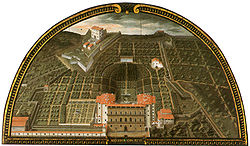
Eleonora di Toledo
Eleanor of Toledo Eleanor of Toledo Eleanor of Toledo (Italian: Eleonora di Toledo (1522 – 17 December 1562), born Doña Leonor Álvarez de Toledo y Osorio, was a Spanish noblewoman who was Duchess of Florence from 1539. She is credited with being the first modern first lady, or consort...
. Raised at the luxurious court of Naples, Eleonora was the wife of Cosimo I de' Medici of Tuscany, later the Grand Duke. On moving into the palace, Cosimo had Vasari enlarge the structure to fit his tastes; the palace was more than doubled by the addition of a new block along the rear. Vasari also built the Vasari Corridor
Vasari Corridor
The Vasari Corridor is an elevated enclosed passageway in Florence, central Italy, which connects the Palazzo Vecchio with the Palazzo Pitti. Beginning on the south side of the Palazzo Vecchio, it then joins the Uffizi Gallery and leaves on its south side, crossing the Lungarno dei Archibusieri...
, an above-ground walkway from Cosimo's old palace and the seat of government, the Palazzo Vecchio
Palazzo Vecchio
The Palazzo Vecchio is the town hall of Florence, Italy. This massive, Romanesque, crenellated fortress-palace is among the most impressive town halls of Tuscany...
, through the Uffizi
Uffizi
The Uffizi Gallery , is a museum in Florence, Italy. It is one of the oldest and most famous art museums of the Western world.-History:...
, above the Ponte Vecchio
Ponte Vecchio
The Ponte Vecchio is a Medieval stone closed-spandrel segmental arch bridge over the Arno River, in Florence, Italy, noted for still having shops built along it, as was once common. Butchers initially occupied the shops; the present tenants are jewellers, art dealers and souvenir sellers...
to the Palazzo Pitti. This enabled the Grand Duke and his family to move easily and safely from their official residence to the Palazzo Pitti. Initially the Palazzo Pitti was used mostly for lodging official guests and for occasional functions of the court, while the Medicis' principal residence remained the Palazzo Vecchio
Palazzo Vecchio
The Palazzo Vecchio is the town hall of Florence, Italy. This massive, Romanesque, crenellated fortress-palace is among the most impressive town halls of Tuscany...
. It was not until the reign of Eleonora's son Ferdinando I
Ferdinando I de' Medici, Grand Duke of Tuscany
Ferdinando I de' Medici, Grand Duke of Tuscany was Grand Duke of Tuscany from 1587 to 1609, having succeeded his older brother Francesco I.-Biography:...
and his wife Cristina of Lorraine
Christina, Grand Duchess of Tuscany
Christina of Lorraine or Chretienne de Lorraine was a member of the House of Lorraine and was the Grand Duchess of Tuscany by marriage...
that the palazzo was occupied on a permanent basis and became home to the Medicis' art collection.
Land on the Boboli hill at the rear of the palazzo was acquired in order to create a large formal park and gardens, today known as the Boboli Gardens
Boboli Gardens
The Boboli Gardens are a park in Florence, Italy, that is home to a collection of sculptures dating from the 16th through the 18th centuries, with some Roman antiquities.-History and layout:...
. The landscape architect employed for this was the Medici court artist Niccolò Tribolo
Niccolò Tribolo
Niccolò di Raffaello di Niccolò dei Pericoli, called "Il Tribolo" was an Italian Mannerist artist in the service of Cosimo I de' Medici in his natal city of Florence.-Life:...
, who died the following year; he was quickly succeeded by Bartolommeo Ammanati. The original design of the gardens centred on an amphitheatre, behind the corps de logis
Corps de logis
Corps de logis is the architectural term which refers to the principal block of a large, usually classical, mansion or palace. It contains the principal rooms, state apartments and an entry. The grandest and finest rooms are often on the first floor above the ground level: this floor is the...
of the palazzo. The first play recorded as performed there was Andria
Andria (comedy)
Andria is a comedy by Terence, a Roman playwright. It was Terence's first play, and he wrote it when he was approximately 19 years old. Terence adapted through translation from Menander's play, although as he is at pains to point out in his prologue he goes beyond mere translation. It was first...
by Terence
Terence
Publius Terentius Afer , better known in English as Terence, was a playwright of the Roman Republic, of North African descent. His comedies were performed for the first time around 170–160 BC. Terentius Lucanus, a Roman senator, brought Terence to Rome as a slave, educated him and later on,...
in 1476. It was followed by many classically inspired plays of Florentine playwrights such as Giovan Battista Cini
Giovan Battista Cini
Giovan Battista Cini was an Italian renaissance playwright at the court of the Medici in Florence.Cini was a member of The Florentine Academy of Art which was founded by Grand Duke Cosimo I at the height of the Medici power during the 16th century...
. Performed for the amusement of the cultivated Medici court, they featured elaborate sets designed by the court architect Baldassarre Lanci
Baldassarre Lanci
Baldassarre Lanci was an Italian architect, inventor, theatrical set designer, and master of perspective of the Renaissance period. Born in Urbino, he spent most of his working life in Tuscany.-Early career:...
.
The cortile and extensions
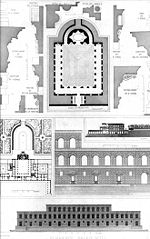
Luxembourg Palace
The Luxembourg Palace in the 6th arrondissement of Paris, north of the Luxembourg Garden , is the seat of the French Senate.The formal Luxembourg Garden presents a 25-hectare green parterre of gravel and lawn populated with statues and provided with large basins of water where children sail model...
. In the principal façade Ammanati also created the finestre inginocchiate ("kneeling" windows, in reference to their imagined resemblance to a prie-dieu
Prie-dieu
A prie-dieu is a type of prayer desk primarily intended for private devotional use, but also often found in churches of the European continent. It is a small ornamental wooden desk furnished with a sloping shelf for books, and a cushioned pad on which to kneel. Sometimes, instead of the sloping...
, a device of Michelangelo
Michelangelo
Michelangelo di Lodovico Buonarroti Simoni , commonly known as Michelangelo, was an Italian Renaissance painter, sculptor, architect, poet, and engineer who exerted an unparalleled influence on the development of Western art...
's), replacing the entrance bays at each end. During the years 1558–70, Ammanati created a monumental staircase to lead with more pomp to the piano nobile
Piano nobile
The piano nobile is the principal floor of a large house, usually built in one of the styles of classical renaissance architecture...
, and he extended the wings on the garden front that embraced a courtyard excavated into the steeply sloping hillside at the same level as the piazza in front, from which it was visible through the central arch of the basement. On the garden side of the courtyard Amannati constructed a grotto
Grotto
A grotto is any type of natural or artificial cave that is associated with modern, historic or prehistoric use by humans. When it is not an artificial garden feature, a grotto is often a small cave near water and often flooded or liable to flood at high tide...
, called the "grotto of Moses" on account of the porphyry
Porphyry (geology)
Porphyry is a variety of igneous rock consisting of large-grained crystals, such as feldspar or quartz, dispersed in a fine-grained feldspathic matrix or groundmass. The larger crystals are called phenocrysts...
statue that inhabits it. On the terrace above it, level with the piano nobile windows, Ammanati constructed a fountain centered on the axis; it was later replaced by the Fontana del Carciofo ("Fountain of the Artichoke"), designed by Giambologna
Giambologna
Giambologna, born as Jean Boulogne, incorrectly known as Giovanni da Bologna and Giovanni Bologna , was a sculptor, known for his marble and bronze statuary in a late Renaissance or Mannerist style.- Biography :...
's former assistant, Francesco Susini, and completed in 1641.
In 1616, a competition was held to design extensions to the principal urban façade by three bays at either end. Giulio Parigi
Giulio Parigi
Giulio Parigi was an Italian architect and designer. He was the main member of a family of architects and designers working for the Grand Ducal court of the Medici...
won the commission; work on the north side began in 1618, and on the south side in 1631 by Alfonso Parigi
Alfonso Parigi
Alfonso Parigi the Younger was an Italian architect and scenographer, the son of Giulio Parigi.He worked mainly in Florence, beginning at a very early age as his father's assistant...
. During the 18th century, two perpendicular wings were constructed by the architect Giuseppe Ruggeri to enhance and stress the widening of via Romana, which creates a piazza
Piazza
A piazza is a city square in Italy, Malta, along the Dalmatian coast and in surrounding regions. The term is roughly equivalent to the Spanish plaza...
centered on the façade, the prototype of the cour d'honneur
Cour d'Honneur
Cour d'Honneur is the architectural term for defining a three-sided courtyard, created when the main central block, or corps de logis, is flanked by symmetrical advancing secondary wings, containing minor rooms...
that was copied in France. Sporadic lesser additions and alterations were made for many years thereafter under other rulers and architects.
To one side of the Gardens is the bizarre grotto designed by Bernardo Buontalenti
Bernardo Buontalenti
Bernardo Buontalenti, byname of Bernardo Delle Girandole was an Italian stage designer, architect, theatrical designer, military engineer and artist.-Biography:Buontalenti was born in Florence....
. The lower façade was begun by Vasari but the architecture of the upper storey is subverted by "dripping" pumice stalactites with the Medici coat of arms at the centre. The interior is similarly poised between architecture and nature; the first chamber has copies of Michelangelo
Michelangelo
Michelangelo di Lodovico Buonarroti Simoni , commonly known as Michelangelo, was an Italian Renaissance painter, sculptor, architect, poet, and engineer who exerted an unparalleled influence on the development of Western art...
's four unfinished slaves emerging from the corners which seem to carry the vault with an open oculus at its centre and painted as a rustic bower with animals, figures and vegetation. Figures, animals and trees made of stucco and rough pumice adorn the lower walls. A short passage leads to a small second chamber and to a third which has a central fountain with Giambologna
Giambologna
Giambologna, born as Jean Boulogne, incorrectly known as Giovanni da Bologna and Giovanni Bologna , was a sculptor, known for his marble and bronze statuary in a late Renaissance or Mannerist style.- Biography :...
's Venus in the centre of the basin, peering fearfully over her shoulder at the four satyrs spitting jets of water at her from the edge.
Houses of Lorraine and Savoy
The palazzo remained the principal Medici residence until the last male Medici heirGian Gastone de' Medici, Grand Duke of Tuscany
Gian Gastone de' Medici was the seventh and last Medicean Grand Duke of Tuscany. He was the second son of Cosimo III de' Medici, Grand Duke of Tuscany, and Marguerite Louise d'Orléans, Princess of France...
died in 1737. It was then occupied briefly by his sister, the elderly Electress Palatine
Anna Maria Luisa de' Medici
Anna Maria Luisa de' Medici was the last scion of the House of Medici. A patron of the arts, she bequeathed the Medici's large art collection, including the contents of the Uffizi, Palazzo Pitti and the Medicean villas, which she inherited upon her brother Gian Gastone's death in 1737, and her...
; on her death, the Medici dynasty became extinct and the palazzo passed to the new Grand Dukes of Tuscany, the Austrian House of Lorraine
House of Lorraine
The House of Lorraine, the main and now only remaining line known as Habsburg-Lorraine, is one of the most important and was one of the longest-reigning royal houses in the history of Europe...
, in the person of Francis I, Holy Roman Emperor
Francis I, Holy Roman Emperor
Francis I was Holy Roman Emperor and Grand Duke of Tuscany, though his wife effectively executed the real power of those positions. With his wife, Maria Theresa, he was the founder of the Habsburg-Lorraine dynasty...
. The Austrian tenancy was briefly interrupted by Napoleon, who used the palazzo during his period of control over Italy.
When Tuscany passed from the House of Lorraine to the House of Savoy
House of Savoy
The House of Savoy was formed in the early 11th century in the historical Savoy region. Through gradual expansion, it grew from ruling a small county in that region to eventually rule the Kingdom of Italy from 1861 until the end of World War II, king of Croatia and King of Armenia...
in 1860, the Palazzo Pitti was included. After the Risorgimento, when Florence was briefly the capital of the Kingdom of Italy, Victor Emmanuel II resided in the palazzo until 1871. His grandson, Victor Emmanuel III, presented the palazzo to the nation in 1919. The palazzo and other buildings in the Boboli Gardens were then divided into five separate art galleries and a museum, housing not only many of its original contents, but priceless artefacts from many other collections acquired by the state. The 140 rooms open to the public are part of an interior, which is in large part a later product than the original portion of the structure, mostly created in two phases, one in the 17th century and the other in the early 18th century. Some earlier interiors remain, and there are still later additions such as the Throne Room. In 2005 the surprise discovery of forgotten 18th-century bathrooms in the palazzo revealed remarkable examples of contemporary plumbing very similar in style to the bathrooms of the 21st century.
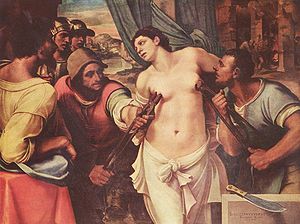


Galleries
- See a partial list of work at Collections of Palazzo Pitti
The palazzo is now the largest museum complex in Florence. The principal palazzo block, often in a building of this design known as the corps de logis
Corps de logis
Corps de logis is the architectural term which refers to the principal block of a large, usually classical, mansion or palace. It contains the principal rooms, state apartments and an entry. The grandest and finest rooms are often on the first floor above the ground level: this floor is the...
, is 32,000 square metres. It is divided into several principal galleries or museums detailed below.
Palatine Gallery
The Palatine Gallery, on the first floor of the piano nobile, contains a large ensemble of over 500 principally Renaissance paintings, which were once part of the Medicis' and their successors' private art collection. The gallery, which overflows into the royal apartments, contains works by RaphaelRaphael
Raffaello Sanzio da Urbino , better known simply as Raphael, was an Italian painter and architect of the High Renaissance. His work is admired for its clarity of form and ease of composition and for its visual achievement of the Neoplatonic ideal of human grandeur...
, Titian
Titian
Tiziano Vecelli or Tiziano Vecellio Tiziano Vecelli or Tiziano Vecellio Tiziano Vecelli or Tiziano Vecellio (c. 1488/1490 – 27 August 1576 better known as Titian was an Italian painter, the most important member of the 16th-century Venetian school. He was born in Pieve di Cadore, near...
, Perugino
Pietro Perugino
Pietro Perugino , born Pietro Vannucci, was an Italian Renaissance painter of the Umbrian school, who developed some of the qualities that found classic expression in the High Renaissance...
(Lamentation over the Dead Christ
Lamentation over the Dead Christ (Perugino)
The Lamentation over the Dead Christ is a painting by the Italian Renaissance painter Pietro Perugino, executed in 1495 and housed in the Galleria Palatina of Palazzo Pitti, Florence, Italy.-History:...
), Correggio, Peter Paul Rubens, and Pietro da Cortona
Pietro da Cortona
Pietro da Cortona, by the name of Pietro Berrettini, born Pietro Berrettini da Cortona, was the leading Italian Baroque painter of his time and also one of the key architects in the emergence of Roman Baroque architecture. He was also an important decorator...
. The character of the gallery is still that of a private collection, and the works of art are displayed and hung much as they would have been in the grand rooms for which they were intended rather than following a chronological sequence, or arranged according to school of art.
The finest rooms were decorated by Pietro da Cortona in the high baroque
Baroque
The Baroque is a period and the style that used exaggerated motion and clear, easily interpreted detail to produce drama, tension, exuberance, and grandeur in sculpture, painting, literature, dance, and music...
style. Initially Cortona frescoed a small room on the piano nobile called the Sala della Stufa with a series depicting the Four Ages of Man which were very well-received; the Age of Gold and Age of Silver were painted in 1637, followed in 1641 by the Age of Bronze and Age of Iron. They are regarded among his masterpieces. The artist was subsequently asked to fresco the grand ducal reception rooms; a suite of five rooms at the front of the palazzo. In these five Planetary Rooms, the hierarchical sequence of the deities is based on Ptolomeic cosmology; Venus, Apollo, Mars, Jupiter (the Medici Throne room) and Saturn, but minus Mercury and the Moon which should have come before Venus. These highly ornate ceilings with frescoes and elaborate stucco work essentially celebrate the Medici lineage and the bestowal of virtuous leadership. Cortona left Florence in 1647, and his pupil and collaborator, Ciro Ferri
Ciro Ferri
Ciro Ferri was an Italian Baroque sculptor and painter, the chief pupil and successor of Pietro da Cortona.He was born in Rome, where he began working under Cortona and with a team of artists in the extensive fresco decorations of the Quirinal Palace...
, completed the cycle by the 1660s. They were to inspire the later Planet Rooms at Louis XIV
Louis XIV of France
Louis XIV , known as Louis the Great or the Sun King , was a Bourbon monarch who ruled as King of France and Navarre. His reign, from 1643 to his death in 1715, began at the age of four and lasted seventy-two years, three months, and eighteen days...
's Versailles
Palace of Versailles
The Palace of Versailles , or simply Versailles, is a royal château in Versailles in the Île-de-France region of France. In French it is the Château de Versailles....
, designed by Le Brun
Charles Le Brun
Charles Le Brun , a French painter and art theorist, became the all-powerful, peerless master of 17th-century French art.-Biography:-Early life and training:...
.
The collection was first opened to the public in the late 18th century, albeit rather reluctantly, by Grand Duke Leopold
Leopold II, Holy Roman Emperor
Leopold II , born Peter Leopold Joseph Anton Joachim Pius Gotthard, was Holy Roman Emperor and King of Hungary and Bohemia from 1790 to 1792, Archduke of Austria and Grand Duke of Tuscany from 1765 to 1790. He was a son of Emperor Francis I and his wife, Empress Maria Theresa...
, Tuscany's first enlightened ruler, keen to obtain popularity after the demise of the Medici.
Royal Apartments
This is a suite of 14 rooms, formerly used by the Medici family, and lived in by their successors. These rooms have been largely altered since the era of the Medici, most recently in the 19th century. They contain a collection of Medici portraits, many of them by the artist Giusto Sustermans. In contrast to the great salons containing the Palatine collection, some of these rooms are much smaller and more intimate, and, while still grand and gilded, are more suited to day-to-day living requirements. Period furnishings include four-poster beds and other necessary furnishings not found elsewhere in the palazzo. The Kings of Italy last used the Palazzo Pitti in the 1920s. By that time it had already been converted to a museum, but a suite of rooms (now the Gallery of Modern Art) was reserved for them when visiting Florence officially.Gallery of Modern Art
This gallery originates from the remodeling of the Florentine academy in 1748, when a gallery of Modern Art was established. The gallery was intended to hold those art works which were prize-winners in the academy's competitions. The Palazzo Pitti was being redecorated on a grand scale at this time and the new works of art were being collected to adorn the newly decorated salons. By the mid-19th century so numerous were the Grand Ducal paintings of modern art that many were transferred to the Palazzo Croncetta, which became the first home of the newly formed "Modern Art Museum".
Today, further enlarged and spread over 30 rooms, this large collection includes works by artists of the Macchiaioli
Macchiaioli
The Macchiaioli were a group of Italian painters active in Tuscany in the second half of the nineteenth century, who, breaking with the antiquated conventions taught by the Italian academies of art, did much of their painting outdoors in order to capture natural light, shade, and colour...
movement and other modern Italian schools of the late 19th and early 20th centuries. The pictures by the Macchiaioli artists are of particular note, as this school of 19th-century Tuscan painters led by Giovanni Fattori
Giovanni Fattori
Giovanni Fattori was an Italian artist, one of the leaders of the group known as the Macchiaioli. He was initially a painter of historical themes and military subjects. In his middle years, inspired by the Barbizon school, he became one of the leading Italian plein-airists, painting landscapes,...
were early pioneers and the founders of the impressionist movement. The title "gallery of modern art" to some may sound incorrect, as the art in the gallery covers the period from the 18th to the early 20th century. No examples of later art are included in the collection since In Italy, "modern art" refers to the period before World War II; what has followed is generally known as "contemporary art" (arte contemporanea). In Tuscany this art can be found at the Centro per l'arte contemporanea Luigi Pecci
Centro per l'arte contemporanea Luigi Pecci
Centro per l'arte contemporanea Luigi Pecci is sited at 277 Via della Repubblica, Prato near Florence, Italy. The centre is devoted to the contemporary arts of the last three decades. The complex composes the Museum of Contemporary Art, the Centre of Information and Documentation, including the...
at Prato
Prato
Prato is a city and comune in Tuscany, Italy, the capital of the Province of Prato. The city is situated at the foot of Monte Retaia , the last peak in the Calvana chain. The lowest altitude in the comune is 32 m, near the Cascine di Tavola, and the highest is the peak of Monte Cantagrillo...
, a city about 15 km (9 mi) from Florence.
Silver Museum
The Silver Museum, sometimes called "The Medici Treasury", contains a collection of priceless silver, cameos, and works in semi-precious gemstoneGemstone
A gemstone or gem is a piece of mineral, which, in cut and polished form, is used to make jewelry or other adornments...
s, many of the latter from the collection of Lorenzo de' Medici
Lorenzo de' Medici
Lorenzo de' Medici was an Italian statesman and de facto ruler of the Florentine Republic during the Italian Renaissance. Known as Lorenzo the Magnificent by contemporary Florentines, he was a diplomat, politician and patron of scholars, artists and poets...
, including his collection of ancient vases, many with delicate silver gilt mounts added for display purposes in the 15th century. These rooms, formerly part of the private royal apartments, are decorated with 17th-century fresco
Fresco
Fresco is any of several related mural painting types, executed on plaster on walls or ceilings. The word fresco comes from the Greek word affresca which derives from the Latin word for "fresh". Frescoes first developed in the ancient world and continued to be popular through the Renaissance...
es, the most splendid being by Giovanni da San Giovanni
Giovanni da San Giovanni
Giovanni da San Giovanni , also known as Giovanni Mannozzi, was an Italian painter of the early Baroque period.-Biography:...
, from 1635 to 1636. The Silver Museum also contains a fine collection of German gold and silver artefacts purchased by Grand Duke Ferdinand
Ferdinand III, Grand Duke of Tuscany
Ferdinand III, Grand Duke of Tuscany was Grand Duke of Tuscany from 1790 to 1801 and, after a period of disenfranchisement, again from 1814 to 1824. He was also the Prince-elector and Grand Duke of Salzburg and Grand Duke of Würzburg .-Biography:Ferdinand was born in Florence, Tuscany, into the...
after his return from exile in 1815, following the French occupation.
Porcelain Museum

Casino
In modern English, a casino is a facility which houses and accommodates certain types of gambling activities. Casinos are most commonly built near or combined with hotels, restaurants, retail shopping, cruise ships or other tourist attractions...
del Cavaliere in the Boboli Gardens. The porcelain is from many of the most notable European porcelain factories, with Sèvres and Meissen
Meissen
Meissen is a town of approximately 30,000 about northwest of Dresden on both banks of the Elbe river in the Free State of Saxony, in eastern Germany. Meissen is the home of Meissen porcelain, the Albrechtsburg castle, the Gothic Meissen Cathedral and the Meissen Frauenkirche...
near Dresden
Dresden
Dresden is the capital city of the Free State of Saxony in Germany. It is situated in a valley on the River Elbe, near the Czech border. The Dresden conurbation is part of the Saxon Triangle metropolitan area....
being well represented. Many items in the collection were gifts to the Florentine rulers from other European sovereigns, while other works were specially commissioned by the Grand Ducal court. Of particular note are several large dinner services by the Vincennes
Vincennes porcelain
The Vincennes porcelain manufactory was established in 1740 in the disused royal Château de Vincennes, in Vincennes, east of Paris, which was from the start the main market for its wares.-History:...
factory, later renamed Sèvres, and a collection of small biscuit
Bisque (pottery)
Bisque porcelain is unglazed, white ceramic ware Examples include bisque dolls.Bisque also refers to "pottery that has been fired but not yet glazed...
figurine
Figurine
A figurine is a statuette that represents a human, deity or animal. Figurines may be realistic or iconic, depending on the skill and intention of the creator. The earliest were made of stone or clay...
s.
Costume Gallery
Situated in a wing known as the "Palazzina della Meridiana", this gallery contains a collection of theatrical costumes dating from the 16th century until the present. It is also the only museum in Italy detailing the history of Italian fashions. One of the newer collections to the palazzo, it was founded in 1983 by Kristen Aschengreen Piacenti; a suite of fourteen rooms, the Meridiana apartments, were completed in 1858.In addition to theatrical costumes, the gallery displays garments worn between the 18th century and the present day. Some of the exhibits are unique to the Palazzo Pitti; these include the 16th-century funeral clothes of Grand Duke Cosimo I de' Medici, and Eleonora of Toledo and her son Garzia, both of whom died of malaria
Malaria
Malaria is a mosquito-borne infectious disease of humans and other animals caused by eukaryotic protists of the genus Plasmodium. The disease results from the multiplication of Plasmodium parasites within red blood cells, causing symptoms that typically include fever and headache, in severe cases...
. Their bodies would have been displayed in state
Lying in state
Lying in state is a term used to describe the tradition in which a coffin is placed on view to allow the public at large to pay their respects to the deceased. It traditionally takes place in the principal government building of a country or city...
wearing their finest clothes, before being reclad in plainer attire before interment
Burial
Burial is the act of placing a person or object into the ground. This is accomplished by excavating a pit or trench, placing an object in it, and covering it over.-History:...
. The gallery also exhibits a collection of mid-20th century costume jewellery. The Sala Meridiana originally sponsored a functional solar meridian instrument, built into the fresco decoration by Anton Domenico Gabbiani
Anton Domenico Gabbiani
Anton Domenico Gabbiani was an Italian painter and active in a late Baroque style.-Biography:Born in Florence, Gabbiani first apprenticed with the Medici court portrait painter Justus Sustermans, then with the Florentine Vincenzo Dandini; subsequently moved to Rome in 1673 he arrived in Rome,...
.
Carriages Museum
This ground floor museum exhibits carriageCarriage
A carriage is a wheeled vehicle for people, usually horse-drawn; litters and sedan chairs are excluded, since they are wheelless vehicles. The carriage is especially designed for private passenger use and for comfort or elegance, though some are also used to transport goods. It may be light,...
s and other conveyances used by the Grand Ducal court mainly in the late 18th and 19th century. The extent of the exhibition prompted one visitor in the 19th century to wonder, "In the name of all that is extraordinary, how can they find room for all these carriages and horses". Some of the carriages are highly decorative, being adorned not only by gilt but by painted landscapes on their panels. Those used on the grandest occasions, such as the "Carrozza d'Oro" (golden carriage), are surmounted by gilt crowns which would have indicated the rank and station of the carriage's occupants. Other carriages on view are those used by the King of the Two Sicilies, and Archbishop
Archbishop
An archbishop is a bishop of higher rank, but not of higher sacramental order above that of the three orders of deacon, priest , and bishop...
s and other Florentine dignitaries.
The Palazzo today

Uffizi
The Uffizi Gallery , is a museum in Florence, Italy. It is one of the oldest and most famous art museums of the Western world.-History:...
, and has ultimate responsibility for 250,000 catalogued works of art. In spite of its metamorphosis from royal residence to a state-owned public building, the palazzo, sitting on its elevated site overlooking Florence, still retains the air and atmosphere of a private collection in a grand house. This is to a great extent due to the "Amici di Palazzo Pitti" (Friends of the Palazzo Pitti), an organisation of volunteers and patrons
Patronage
Patronage is the support, encouragement, privilege, or financial aid that an organization or individual bestows to another. In the history of art, arts patronage refers to the support that kings or popes have provided to musicians, painters, and sculptors...
founded in 1996, which raises funds and makes suggestions for the ongoing maintenance of the palazzo and the collections, and for the continuing improvement of their visual display.
Florence receives more than five million visitors each year, and for many of them the Palazzo Pitti is an essential stop. Thus the palazzo still impresses visitors with the splendours of Florence, the purpose for which it was originally built.
External links
- Official website
- The Museums of Florence - Pitti Palace - Galleria Palatina
- The Museums of Florence - Pitti Palace - Modern Art Gallery
- The Museums of Florence - Pitti Palace - Silver museum
- The Museums of Florence - Pitti Palace - Porcelain Museum
- The Museums of Florence - Pitti Palace - Boboli Garden
- Pitti Square,Virutal Tour

